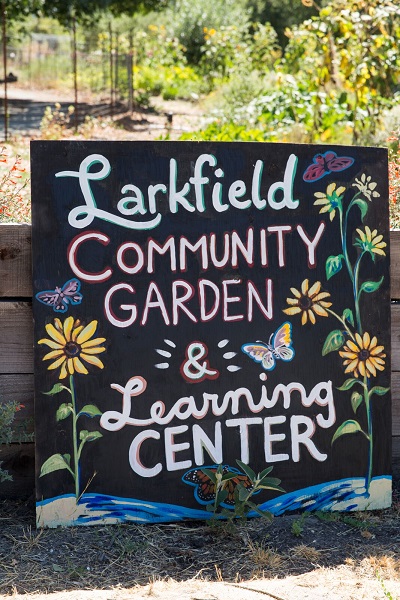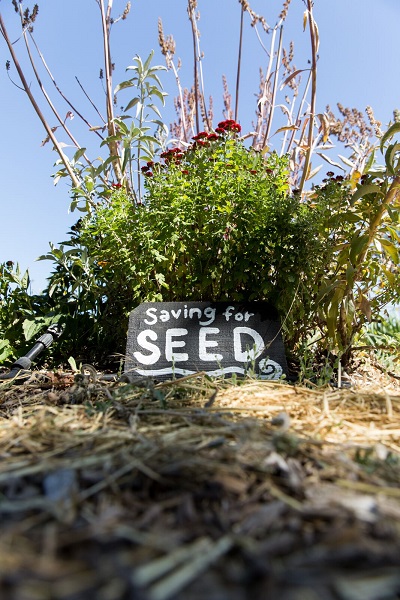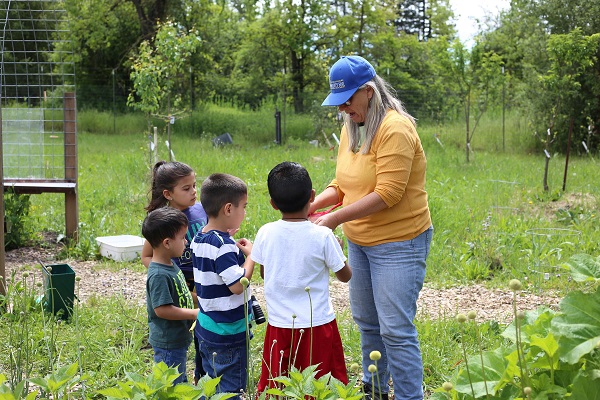Community Soil Foundation is growing more than a garden on formerly neglected county-owned land
If you’ve ever spent any amount of time around permaculturists—people who view nature as the ultimate design manual for gardening, building, and living— you’ve probably heard of a principle called “stacking functions.” This means the elements in any design should have multiple functions, used to the fullest. Looking for privacy? Instead of building a fence, you could plant a hedge that provides food, fl owers, and habitat for wildlife and humans. It’s a principle seen repeatedly in the natural world.
So, what if you took that principle a step further and applied it to urban and suburban public land use—like parks? What might happen if you consciously designed a plot of land to serve multiple functions—a school garden, native plant incubator, community farm, pollinator habitat, and gathering space? A space designed for supporting the mental and physical health of all users? The Community Soil Foundation (CSF), a Santa Rosa nonprofi t, was born in 2012 from those very questions. And the result is the Larkfi eld Community Garden and Learning Center, where a brambly swath of blackberries and oaks on Noonan Ranch Lane, adjacent to a baseball fi eld and elementary school and nestled between the 101 and a tract of staunchly suburban homes, has been transformed into a bio-intensive farm, school garden, and native plant stewardship effort.
“We want people to understand their place, seasonality, and health,” says Paolo Tanterelli, CSF’s cofounder along with Jeff Shields and Melissa Struzzo. A trifecta propels the project: Connect with schools. Connect with community. Connect with the local ecology.
The nonprofit started out as a private enterprise. Nine years ago, Tanterelli and Shields launched Community Soil, an edible and sustainable garden business. As they built ecologically beautiful landscapes for clients, they wondered how to make the benefits available to a broader community.
“We were putting in habitat gardens and hedgerows, but they were always at a house at the end of the road, and it ended in a fence,” says Tantarelli.
Then came the County Lands for Food Production Initiative (CLFP)—which was created to bring county-owned land into food production through the development of community gardens and leases to local farmers and ranchers. Currently, 4,500 acres of Sonoma County land fall within this category. Shields learned about the initiative at an event hosted by County Supervisor (now California state senator) Mike McGuire. When Shields approached McGuire with ideas about a parcel of land owned by Sonoma County Regional Parks next to Mark West Elementary, he immediately had the supervisor’s ear. The leap into the nonprofi t world began. But, it would take three years of public meetings, stakeholder engagement, and bureaucratic navigation before breaking ground.
 The Larkfield site was strategically chosen. For one, it lies at the intersection of a school, a regional park, a large neighborhood, and oak woodlands—meaning lots of opportunities for community engagement and native habitat restoration. The second reason was more personal. Tantarelli grew up in the area and attended Mark West Elementary School (his parents still live in Larkfi eld) and Shields lives off nearby Mark West Springs Road (he and his family were evacuated for a month after last year’s wildfi res) and his son attends the school. They were invested in the place.
The Larkfield site was strategically chosen. For one, it lies at the intersection of a school, a regional park, a large neighborhood, and oak woodlands—meaning lots of opportunities for community engagement and native habitat restoration. The second reason was more personal. Tantarelli grew up in the area and attended Mark West Elementary School (his parents still live in Larkfi eld) and Shields lives off nearby Mark West Springs Road (he and his family were evacuated for a month after last year’s wildfi res) and his son attends the school. They were invested in the place.
The project didn’t go unchallenged. Some neighbors worried the community farm would bring an uptick in traffic, noise, and crime. “They thought that we were going to have an all-night party,” Tantarelli says. “But we have families and kids, and all we want is to garden and incorporate health and connect with our place.”
An ongoing financial donation from Sutter Health and a partnership with the Mark West Union School district gave the project wings, says Shields. When James Gore was elected to fill McGuire’s supervisor seat, he became an advocate. Fiscal sponsorship from Extended Child Care and funding for the school garden program from the Sonoma County Department of Health Services were boons. Persistence helped too.
“We never missed a meeting,” recalls Shields. “We are invested in this community. We are part of this community. Once we started, they understood that we weren’t going away.”
Today, the five-acre site is home to a working community farm managed by coordinator Catherine Sieck, a former garden intern at the Occidental Arts and Ecology Center. The farm also acts as the school garden for the neighboring campuses (see sidebar). CSF staff cultivate tomatoes, squash, herbs, and cut flowers using a combination of bio-intensive and French intensive—a nature-based method of smaller-space, less water-intensive gardening, integrated pest management, and composting. There’s an outdoor kitchen for workshops and cooking lessons. Monthly workdays on the first Saturday give neighbors an opportunity to work the land (there are no individual plots) and to learn about soil health, seasonal planting, and seed-saving. Last year, the farm produced 3,500 pounds of produce, which was sold at the farmstand, given out to volunteers and students, and donated to food banks.
“Land stewardship is another important aspect,” says Shields. Soon, they’ll plant additional natives, build trails, and add interpretive signage and outdoor classrooms in the oak woodland behind the garden. Most importantly, this remains public land.
“We want folks to see this as their backyard,” says program director Kristin Maharg Suarez. “It’s open sunrise to sunset like a public park. Anybody can come in. We just ask that people don’t remove any of the plants or materials before consulting with staff. If you see us working here, you can pull us aside and ask questions.”
“This is an educational garden rather than a money-making enterprise,” adds Sieck before a lesson on winnowing amaranth seeds. The garden is like a library, she says, a place where students and community members can discover the “secret life of plants.”
After the Tubbs fire ripped through north Santa Rosa, CSF developed another arm called Healthy Habitats. In the immediate aftermath, CSF was integral to the emergency efforts to protect watersheds and soil health in fire-scorched areas. Supported by a $50,000 grant from Sonoma Clean Power, Healthy Habitats has continued the work of regenerating soil health and replenishing oak tree populations through 2018. Students have been collecting acorns and sowing oak trees in the native plant nursery. This coming winter, the seedlings will be planted on rebuilt home sites.
In addition to expanding CSF’s capacity in their current location, they’d like to create a model that’s replicable on other underutilized parcels of public land across the county—especially those that hold potential for a triangle of partnership between schools districts, land owners, and nonprofit organizations.
“The definition of stewardship is tending land that’s not your own and taking responsibility for our role in this world,” says Maharg Suarez. “We’d like to show that there’s another way that we can live in companionship and harmony with the natural world.”
Kids Dig In
School garden programs can have a terrific impact on student learning and health outcomes. Yet, for busy administrators and teachers starting and maintaining a garden program is a challenge. The Community Soil Foundation has addressed this problem by building a community garden, maintained by their own staff, right next to Mark West Elementary, a Title I school in northeast Santa Rosa. (Public schools get Title I designation—and federal funding— when they serve a high percentage of students from low-income families).
CSF’s school garden educator Nancy Johnson provides “learn by doing” instruction and nature experiences to about 350 elementary students a week, who walk over from the neighboring campus with their teachers. Johnson teaches them about plant structure, germination, pollination, and seed spreading. They get lessons on caring for plants through seasonal cycles and harvest, and they prepare simple recipes like Rainbow Salsa in the outdoor kitchen area. Students also keep nature journals and take walks in the oak woodland, learning to identify birds and other wildlife. The age- and grade level appropriate curriculum ties into California Common Core standards. “The farm beds that produce organic produce, California native plant habitat gardens, and adjacent oak forest provide endless teachable moments, every day and season of the school years,” says Johnson.
